Organizational Learning and Value Creation
VerifiedAdded on 2019/12/28
|18
|5294
|210
Essay
AI Summary
In this assignment, we explore the concept of value creation and learning in the context of human resource architecture. We examine various articles and books that discuss the importance of extending HR architecture to create value. The classic book by Knowles et al. (2014) highlights the significance of adult learners in HR development. Additionally, we analyze several research studies that focus on topics such as supplier development, social capital accumulation, competence development, psychological capital development, firm resource management, and high-performance human resource practices. We also touch upon learning styles and the concept of a learning curve.
Contribute Materials
Your contribution can guide someone’s learning journey. Share your
documents today.
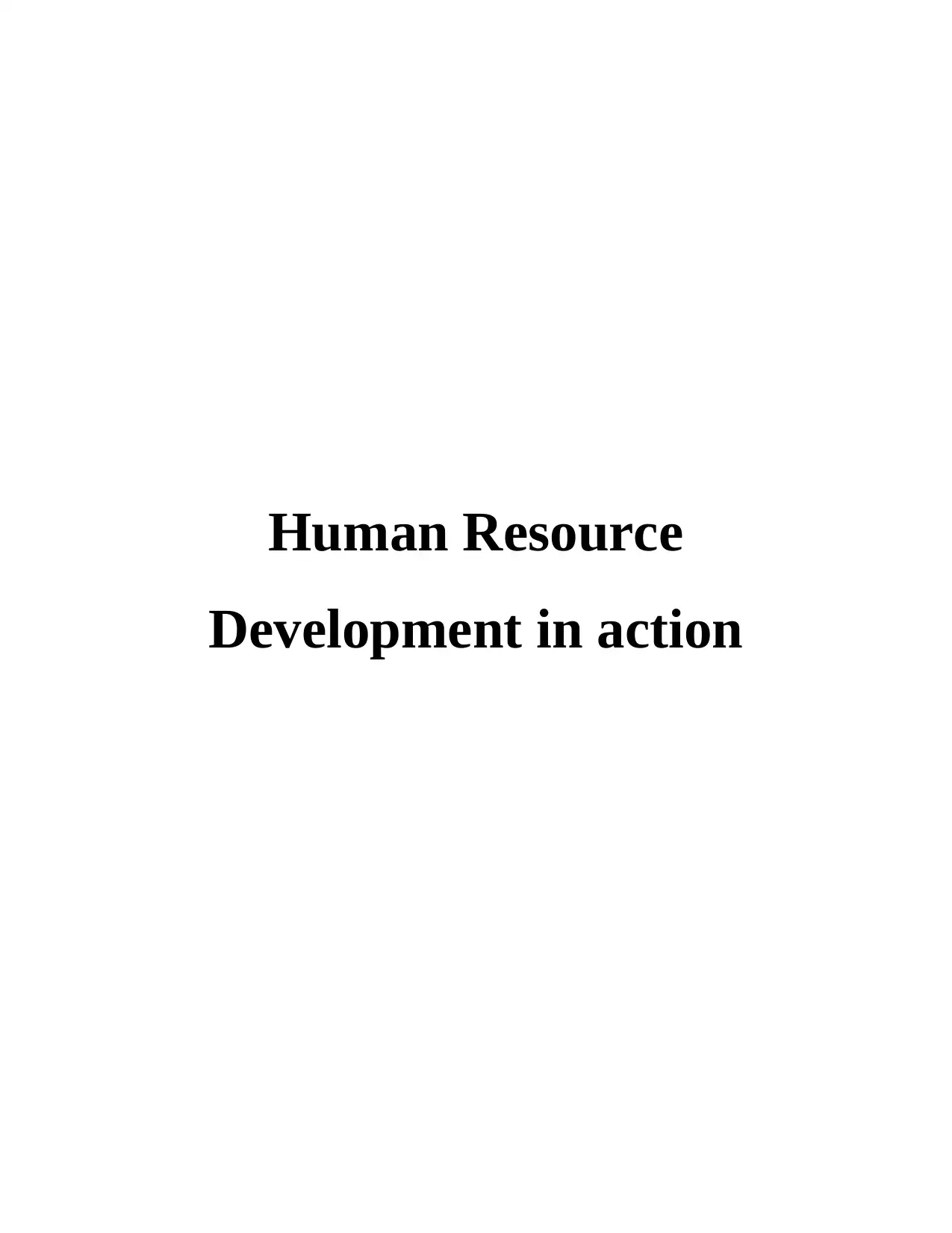
Human Resource
Development in action
Development in action
Secure Best Marks with AI Grader
Need help grading? Try our AI Grader for instant feedback on your assignments.
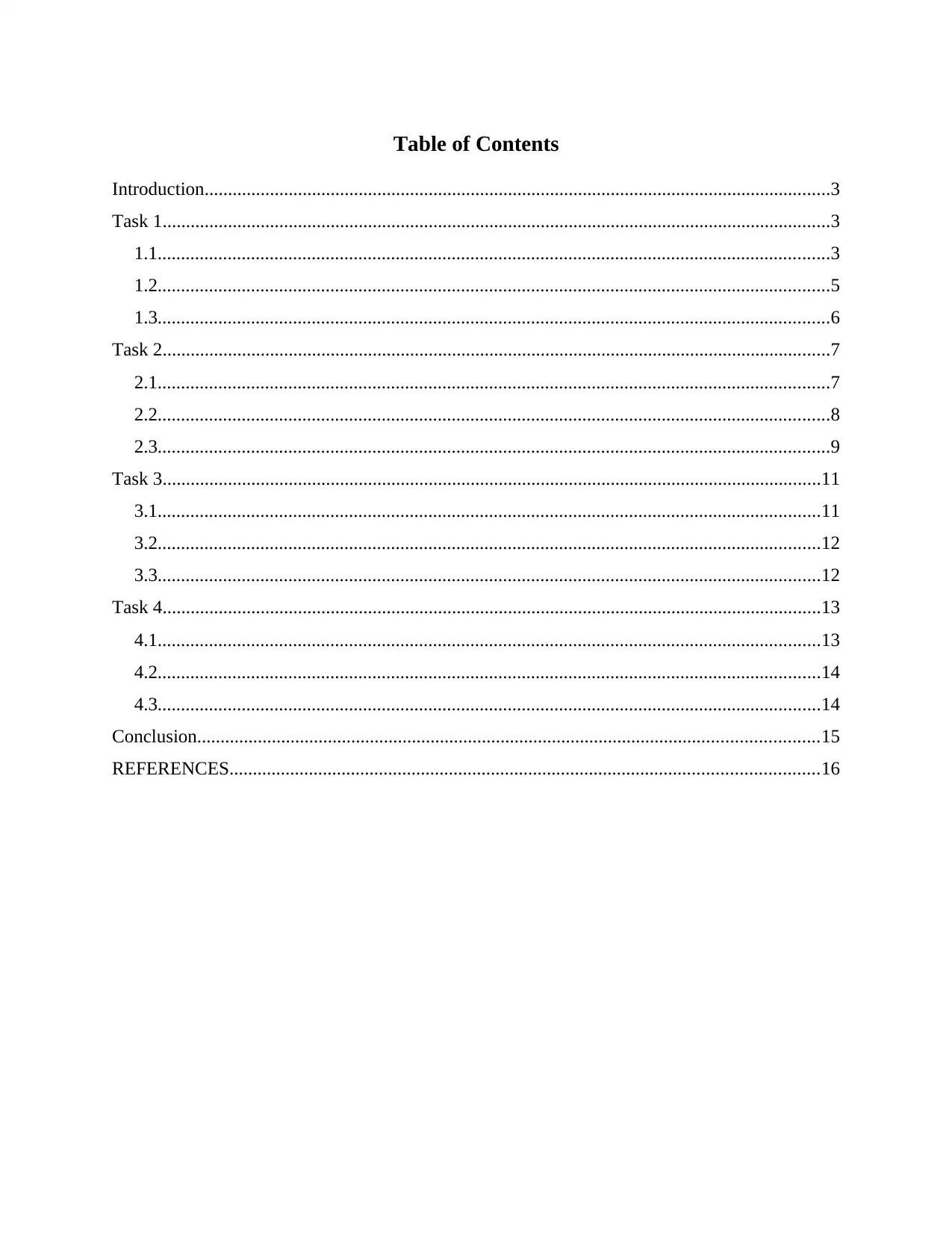
Table of Contents
Introduction......................................................................................................................................3
Task 1...............................................................................................................................................3
1.1................................................................................................................................................3
1.2................................................................................................................................................5
1.3................................................................................................................................................6
Task 2...............................................................................................................................................7
2.1................................................................................................................................................7
2.2................................................................................................................................................8
2.3................................................................................................................................................9
Task 3.............................................................................................................................................11
3.1..............................................................................................................................................11
3.2..............................................................................................................................................12
3.3..............................................................................................................................................12
Task 4.............................................................................................................................................13
4.1..............................................................................................................................................13
4.2..............................................................................................................................................14
4.3..............................................................................................................................................14
Conclusion.....................................................................................................................................15
REFERENCES..............................................................................................................................16
Introduction......................................................................................................................................3
Task 1...............................................................................................................................................3
1.1................................................................................................................................................3
1.2................................................................................................................................................5
1.3................................................................................................................................................6
Task 2...............................................................................................................................................7
2.1................................................................................................................................................7
2.2................................................................................................................................................8
2.3................................................................................................................................................9
Task 3.............................................................................................................................................11
3.1..............................................................................................................................................11
3.2..............................................................................................................................................12
3.3..............................................................................................................................................12
Task 4.............................................................................................................................................13
4.1..............................................................................................................................................13
4.2..............................................................................................................................................14
4.3..............................................................................................................................................14
Conclusion.....................................................................................................................................15
REFERENCES..............................................................................................................................16
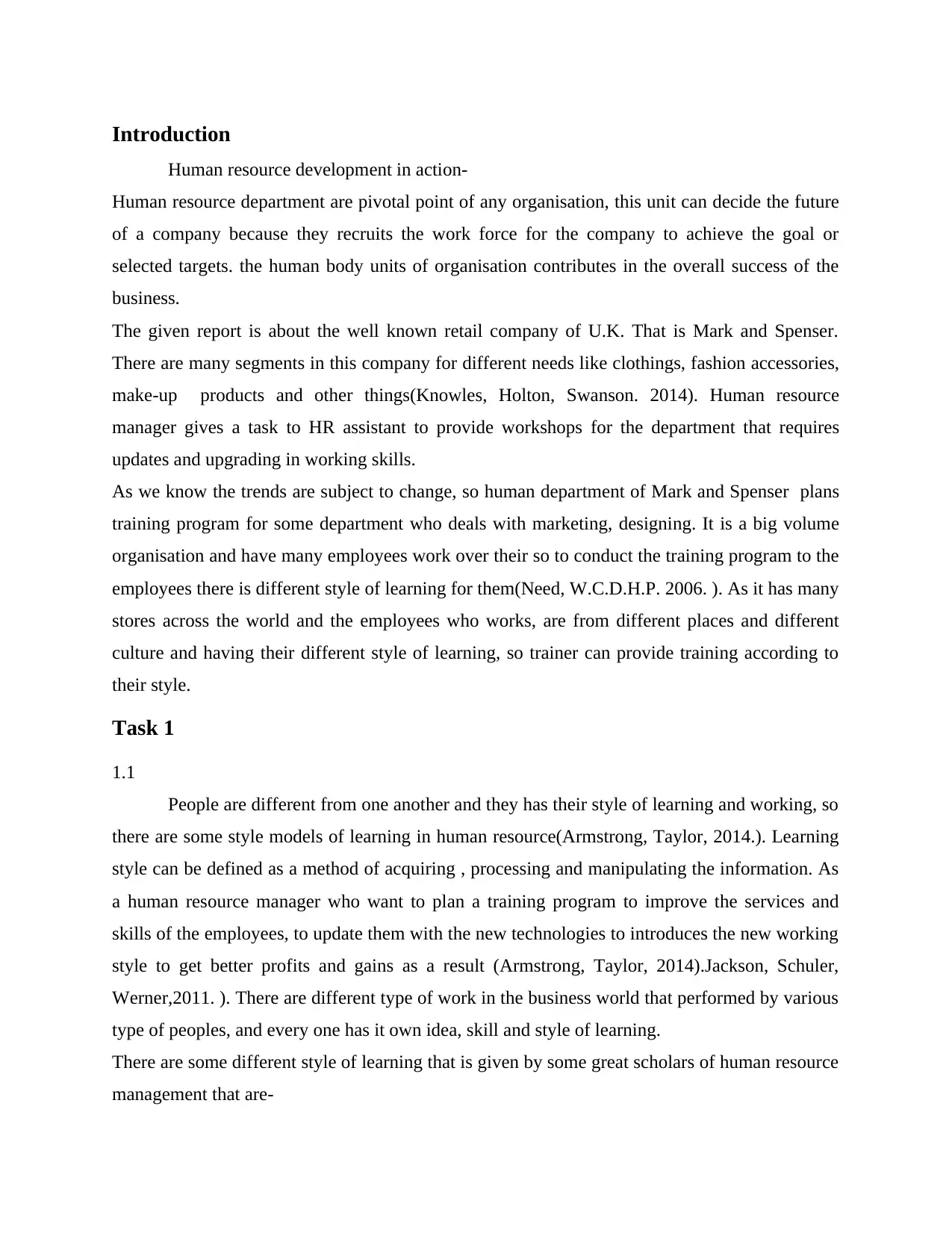
Introduction
Human resource development in action-
Human resource department are pivotal point of any organisation, this unit can decide the future
of a company because they recruits the work force for the company to achieve the goal or
selected targets. the human body units of organisation contributes in the overall success of the
business.
The given report is about the well known retail company of U.K. That is Mark and Spenser.
There are many segments in this company for different needs like clothings, fashion accessories,
make-up products and other things(Knowles, Holton, Swanson. 2014). Human resource
manager gives a task to HR assistant to provide workshops for the department that requires
updates and upgrading in working skills.
As we know the trends are subject to change, so human department of Mark and Spenser plans
training program for some department who deals with marketing, designing. It is a big volume
organisation and have many employees work over their so to conduct the training program to the
employees there is different style of learning for them(Need, W.C.D.H.P. 2006. ). As it has many
stores across the world and the employees who works, are from different places and different
culture and having their different style of learning, so trainer can provide training according to
their style.
Task 1
1.1
People are different from one another and they has their style of learning and working, so
there are some style models of learning in human resource(Armstrong, Taylor, 2014.). Learning
style can be defined as a method of acquiring , processing and manipulating the information. As
a human resource manager who want to plan a training program to improve the services and
skills of the employees, to update them with the new technologies to introduces the new working
style to get better profits and gains as a result (Armstrong, Taylor, 2014).Jackson, Schuler,
Werner,2011. ). There are different type of work in the business world that performed by various
type of peoples, and every one has it own idea, skill and style of learning.
There are some different style of learning that is given by some great scholars of human resource
management that are-
Human resource development in action-
Human resource department are pivotal point of any organisation, this unit can decide the future
of a company because they recruits the work force for the company to achieve the goal or
selected targets. the human body units of organisation contributes in the overall success of the
business.
The given report is about the well known retail company of U.K. That is Mark and Spenser.
There are many segments in this company for different needs like clothings, fashion accessories,
make-up products and other things(Knowles, Holton, Swanson. 2014). Human resource
manager gives a task to HR assistant to provide workshops for the department that requires
updates and upgrading in working skills.
As we know the trends are subject to change, so human department of Mark and Spenser plans
training program for some department who deals with marketing, designing. It is a big volume
organisation and have many employees work over their so to conduct the training program to the
employees there is different style of learning for them(Need, W.C.D.H.P. 2006. ). As it has many
stores across the world and the employees who works, are from different places and different
culture and having their different style of learning, so trainer can provide training according to
their style.
Task 1
1.1
People are different from one another and they has their style of learning and working, so
there are some style models of learning in human resource(Armstrong, Taylor, 2014.). Learning
style can be defined as a method of acquiring , processing and manipulating the information. As
a human resource manager who want to plan a training program to improve the services and
skills of the employees, to update them with the new technologies to introduces the new working
style to get better profits and gains as a result (Armstrong, Taylor, 2014).Jackson, Schuler,
Werner,2011. ). There are different type of work in the business world that performed by various
type of peoples, and every one has it own idea, skill and style of learning.
There are some different style of learning that is given by some great scholars of human resource
management that are-
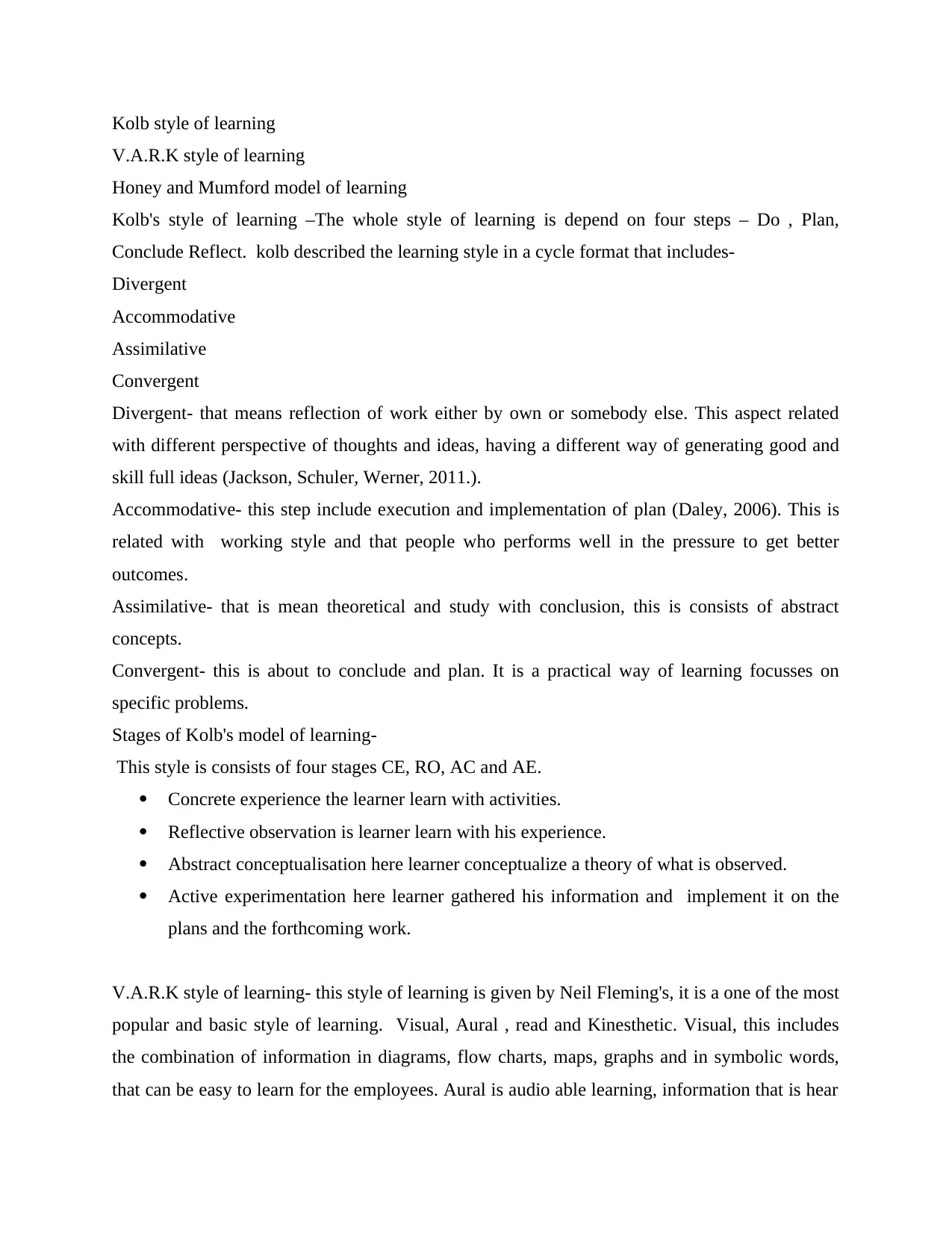
Kolb style of learning
V.A.R.K style of learning
Honey and Mumford model of learning
Kolb's style of learning –The whole style of learning is depend on four steps – Do , Plan,
Conclude Reflect. kolb described the learning style in a cycle format that includes-
Divergent
Accommodative
Assimilative
Convergent
Divergent- that means reflection of work either by own or somebody else. This aspect related
with different perspective of thoughts and ideas, having a different way of generating good and
skill full ideas (Jackson, Schuler, Werner, 2011.).
Accommodative- this step include execution and implementation of plan (Daley, 2006). This is
related with working style and that people who performs well in the pressure to get better
outcomes.
Assimilative- that is mean theoretical and study with conclusion, this is consists of abstract
concepts.
Convergent- this is about to conclude and plan. It is a practical way of learning focusses on
specific problems.
Stages of Kolb's model of learning-
This style is consists of four stages CE, RO, AC and AE.
Concrete experience the learner learn with activities.
Reflective observation is learner learn with his experience.
Abstract conceptualisation here learner conceptualize a theory of what is observed.
Active experimentation here learner gathered his information and implement it on the
plans and the forthcoming work.
V.A.R.K style of learning- this style of learning is given by Neil Fleming's, it is a one of the most
popular and basic style of learning. Visual, Aural , read and Kinesthetic. Visual, this includes
the combination of information in diagrams, flow charts, maps, graphs and in symbolic words,
that can be easy to learn for the employees. Aural is audio able learning, information that is hear
V.A.R.K style of learning
Honey and Mumford model of learning
Kolb's style of learning –The whole style of learning is depend on four steps – Do , Plan,
Conclude Reflect. kolb described the learning style in a cycle format that includes-
Divergent
Accommodative
Assimilative
Convergent
Divergent- that means reflection of work either by own or somebody else. This aspect related
with different perspective of thoughts and ideas, having a different way of generating good and
skill full ideas (Jackson, Schuler, Werner, 2011.).
Accommodative- this step include execution and implementation of plan (Daley, 2006). This is
related with working style and that people who performs well in the pressure to get better
outcomes.
Assimilative- that is mean theoretical and study with conclusion, this is consists of abstract
concepts.
Convergent- this is about to conclude and plan. It is a practical way of learning focusses on
specific problems.
Stages of Kolb's model of learning-
This style is consists of four stages CE, RO, AC and AE.
Concrete experience the learner learn with activities.
Reflective observation is learner learn with his experience.
Abstract conceptualisation here learner conceptualize a theory of what is observed.
Active experimentation here learner gathered his information and implement it on the
plans and the forthcoming work.
V.A.R.K style of learning- this style of learning is given by Neil Fleming's, it is a one of the most
popular and basic style of learning. Visual, Aural , read and Kinesthetic. Visual, this includes
the combination of information in diagrams, flow charts, maps, graphs and in symbolic words,
that can be easy to learn for the employees. Aural is audio able learning, information that is hear
Secure Best Marks with AI Grader
Need help grading? Try our AI Grader for instant feedback on your assignments.
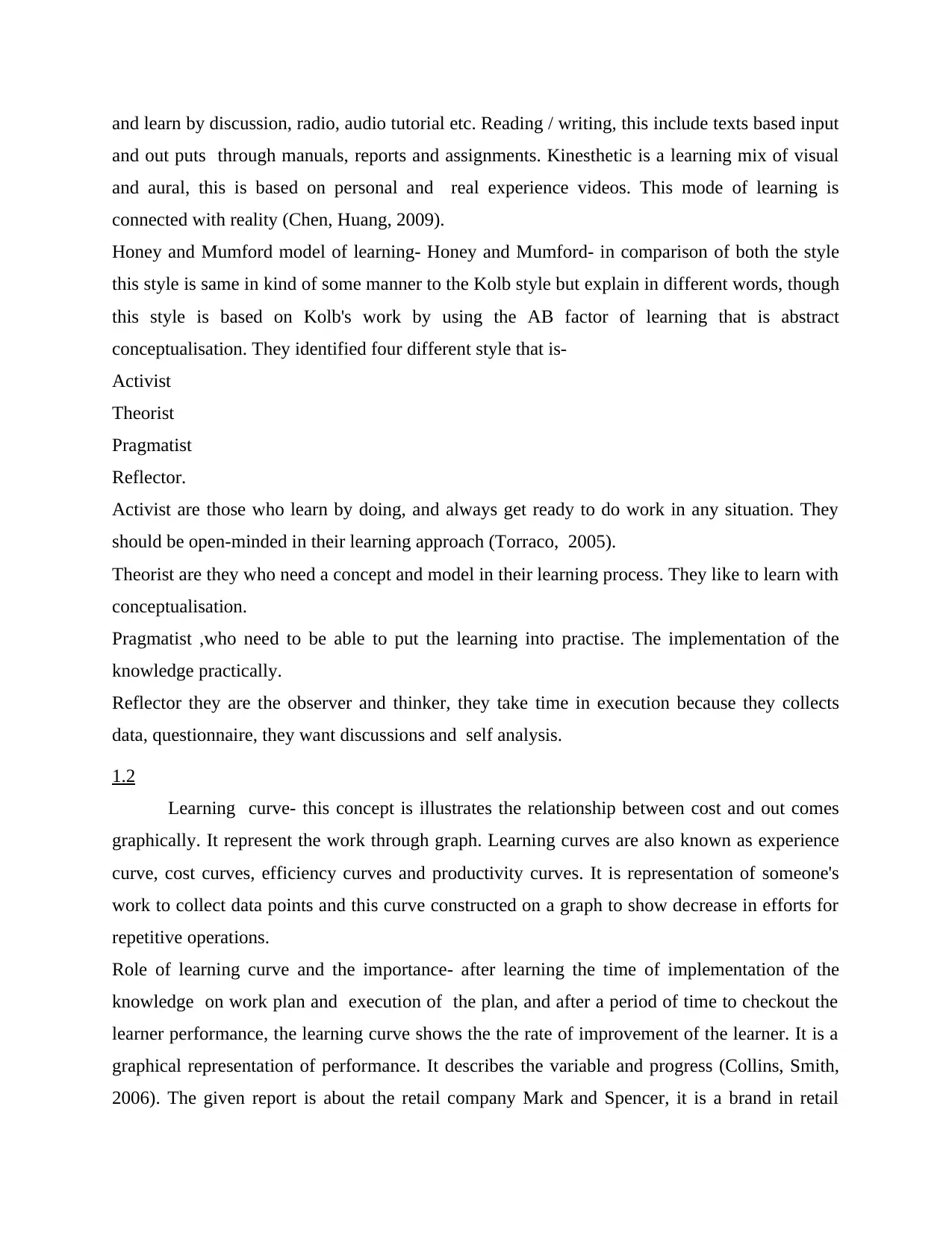
and learn by discussion, radio, audio tutorial etc. Reading / writing, this include texts based input
and out puts through manuals, reports and assignments. Kinesthetic is a learning mix of visual
and aural, this is based on personal and real experience videos. This mode of learning is
connected with reality (Chen, Huang, 2009).
Honey and Mumford model of learning- Honey and Mumford- in comparison of both the style
this style is same in kind of some manner to the Kolb style but explain in different words, though
this style is based on Kolb's work by using the AB factor of learning that is abstract
conceptualisation. They identified four different style that is-
Activist
Theorist
Pragmatist
Reflector.
Activist are those who learn by doing, and always get ready to do work in any situation. They
should be open-minded in their learning approach (Torraco, 2005).
Theorist are they who need a concept and model in their learning process. They like to learn with
conceptualisation.
Pragmatist ,who need to be able to put the learning into practise. The implementation of the
knowledge practically.
Reflector they are the observer and thinker, they take time in execution because they collects
data, questionnaire, they want discussions and self analysis.
1.2
Learning curve- this concept is illustrates the relationship between cost and out comes
graphically. It represent the work through graph. Learning curves are also known as experience
curve, cost curves, efficiency curves and productivity curves. It is representation of someone's
work to collect data points and this curve constructed on a graph to show decrease in efforts for
repetitive operations.
Role of learning curve and the importance- after learning the time of implementation of the
knowledge on work plan and execution of the plan, and after a period of time to checkout the
learner performance, the learning curve shows the the rate of improvement of the learner. It is a
graphical representation of performance. It describes the variable and progress (Collins, Smith,
2006). The given report is about the retail company Mark and Spencer, it is a brand in retail
and out puts through manuals, reports and assignments. Kinesthetic is a learning mix of visual
and aural, this is based on personal and real experience videos. This mode of learning is
connected with reality (Chen, Huang, 2009).
Honey and Mumford model of learning- Honey and Mumford- in comparison of both the style
this style is same in kind of some manner to the Kolb style but explain in different words, though
this style is based on Kolb's work by using the AB factor of learning that is abstract
conceptualisation. They identified four different style that is-
Activist
Theorist
Pragmatist
Reflector.
Activist are those who learn by doing, and always get ready to do work in any situation. They
should be open-minded in their learning approach (Torraco, 2005).
Theorist are they who need a concept and model in their learning process. They like to learn with
conceptualisation.
Pragmatist ,who need to be able to put the learning into practise. The implementation of the
knowledge practically.
Reflector they are the observer and thinker, they take time in execution because they collects
data, questionnaire, they want discussions and self analysis.
1.2
Learning curve- this concept is illustrates the relationship between cost and out comes
graphically. It represent the work through graph. Learning curves are also known as experience
curve, cost curves, efficiency curves and productivity curves. It is representation of someone's
work to collect data points and this curve constructed on a graph to show decrease in efforts for
repetitive operations.
Role of learning curve and the importance- after learning the time of implementation of the
knowledge on work plan and execution of the plan, and after a period of time to checkout the
learner performance, the learning curve shows the the rate of improvement of the learner. It is a
graphical representation of performance. It describes the variable and progress (Collins, Smith,
2006). The given report is about the retail company Mark and Spencer, it is a brand in retail
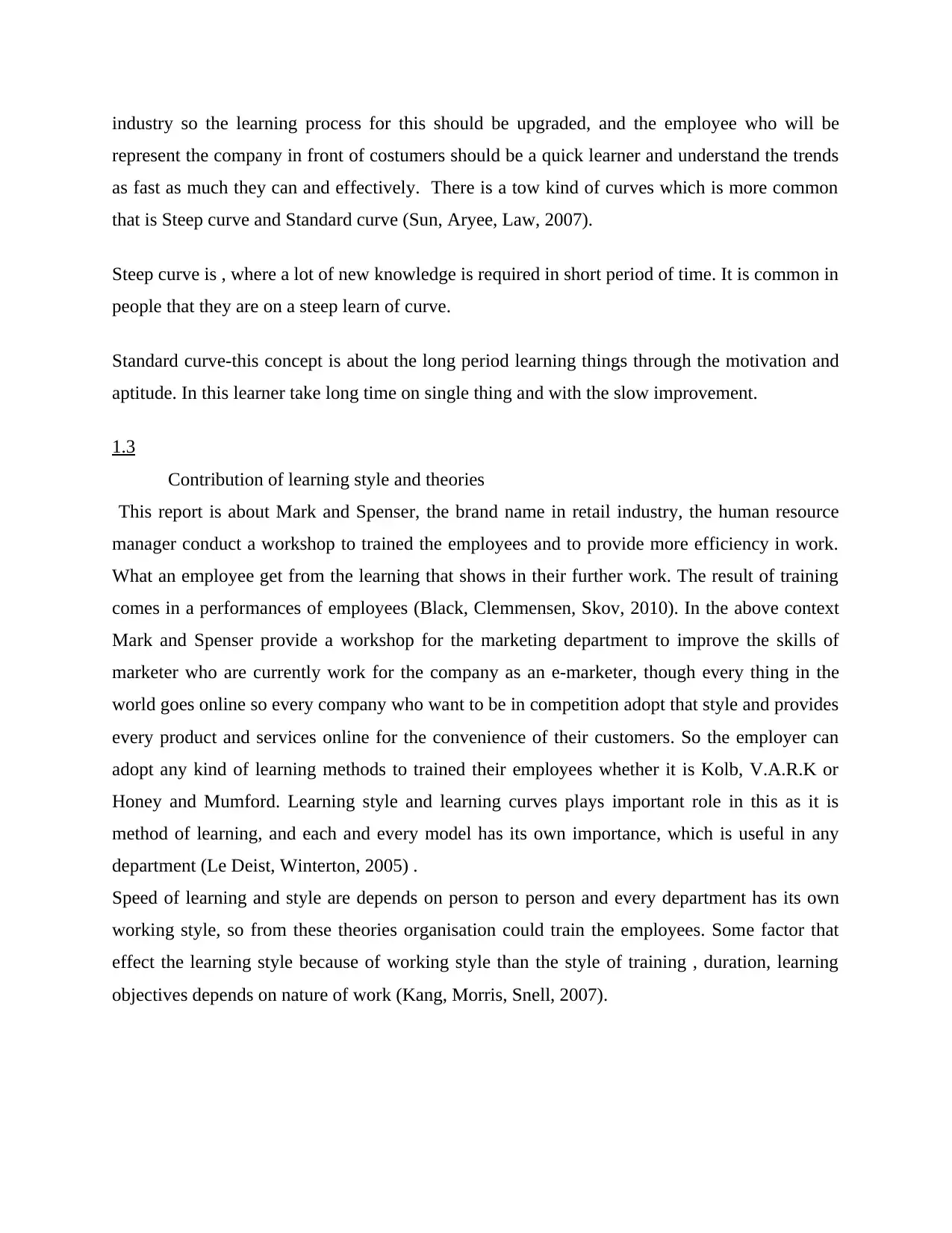
industry so the learning process for this should be upgraded, and the employee who will be
represent the company in front of costumers should be a quick learner and understand the trends
as fast as much they can and effectively. There is a tow kind of curves which is more common
that is Steep curve and Standard curve (Sun, Aryee, Law, 2007).
Steep curve is , where a lot of new knowledge is required in short period of time. It is common in
people that they are on a steep learn of curve.
Standard curve-this concept is about the long period learning things through the motivation and
aptitude. In this learner take long time on single thing and with the slow improvement.
1.3
Contribution of learning style and theories
This report is about Mark and Spenser, the brand name in retail industry, the human resource
manager conduct a workshop to trained the employees and to provide more efficiency in work.
What an employee get from the learning that shows in their further work. The result of training
comes in a performances of employees (Black, Clemmensen, Skov, 2010). In the above context
Mark and Spenser provide a workshop for the marketing department to improve the skills of
marketer who are currently work for the company as an e-marketer, though every thing in the
world goes online so every company who want to be in competition adopt that style and provides
every product and services online for the convenience of their customers. So the employer can
adopt any kind of learning methods to trained their employees whether it is Kolb, V.A.R.K or
Honey and Mumford. Learning style and learning curves plays important role in this as it is
method of learning, and each and every model has its own importance, which is useful in any
department (Le Deist, Winterton, 2005) .
Speed of learning and style are depends on person to person and every department has its own
working style, so from these theories organisation could train the employees. Some factor that
effect the learning style because of working style than the style of training , duration, learning
objectives depends on nature of work (Kang, Morris, Snell, 2007).
represent the company in front of costumers should be a quick learner and understand the trends
as fast as much they can and effectively. There is a tow kind of curves which is more common
that is Steep curve and Standard curve (Sun, Aryee, Law, 2007).
Steep curve is , where a lot of new knowledge is required in short period of time. It is common in
people that they are on a steep learn of curve.
Standard curve-this concept is about the long period learning things through the motivation and
aptitude. In this learner take long time on single thing and with the slow improvement.
1.3
Contribution of learning style and theories
This report is about Mark and Spenser, the brand name in retail industry, the human resource
manager conduct a workshop to trained the employees and to provide more efficiency in work.
What an employee get from the learning that shows in their further work. The result of training
comes in a performances of employees (Black, Clemmensen, Skov, 2010). In the above context
Mark and Spenser provide a workshop for the marketing department to improve the skills of
marketer who are currently work for the company as an e-marketer, though every thing in the
world goes online so every company who want to be in competition adopt that style and provides
every product and services online for the convenience of their customers. So the employer can
adopt any kind of learning methods to trained their employees whether it is Kolb, V.A.R.K or
Honey and Mumford. Learning style and learning curves plays important role in this as it is
method of learning, and each and every model has its own importance, which is useful in any
department (Le Deist, Winterton, 2005) .
Speed of learning and style are depends on person to person and every department has its own
working style, so from these theories organisation could train the employees. Some factor that
effect the learning style because of working style than the style of training , duration, learning
objectives depends on nature of work (Kang, Morris, Snell, 2007).
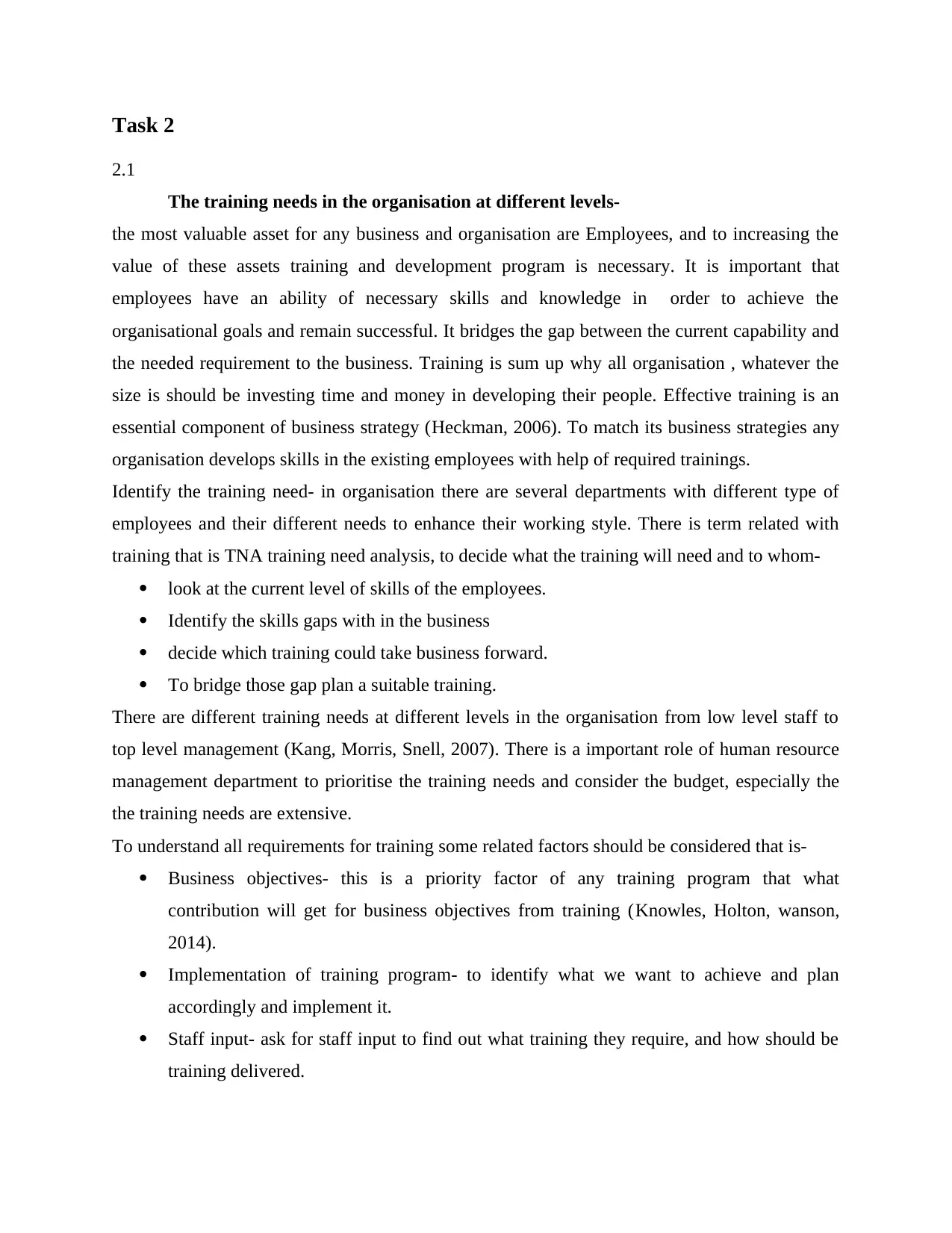
Task 2
2.1
The training needs in the organisation at different levels-
the most valuable asset for any business and organisation are Employees, and to increasing the
value of these assets training and development program is necessary. It is important that
employees have an ability of necessary skills and knowledge in order to achieve the
organisational goals and remain successful. It bridges the gap between the current capability and
the needed requirement to the business. Training is sum up why all organisation , whatever the
size is should be investing time and money in developing their people. Effective training is an
essential component of business strategy (Heckman, 2006). To match its business strategies any
organisation develops skills in the existing employees with help of required trainings.
Identify the training need- in organisation there are several departments with different type of
employees and their different needs to enhance their working style. There is term related with
training that is TNA training need analysis, to decide what the training will need and to whom-
look at the current level of skills of the employees.
Identify the skills gaps with in the business
decide which training could take business forward.
To bridge those gap plan a suitable training.
There are different training needs at different levels in the organisation from low level staff to
top level management (Kang, Morris, Snell, 2007). There is a important role of human resource
management department to prioritise the training needs and consider the budget, especially the
the training needs are extensive.
To understand all requirements for training some related factors should be considered that is-
Business objectives- this is a priority factor of any training program that what
contribution will get for business objectives from training (Knowles, Holton, wanson,
2014).
Implementation of training program- to identify what we want to achieve and plan
accordingly and implement it.
Staff input- ask for staff input to find out what training they require, and how should be
training delivered.
2.1
The training needs in the organisation at different levels-
the most valuable asset for any business and organisation are Employees, and to increasing the
value of these assets training and development program is necessary. It is important that
employees have an ability of necessary skills and knowledge in order to achieve the
organisational goals and remain successful. It bridges the gap between the current capability and
the needed requirement to the business. Training is sum up why all organisation , whatever the
size is should be investing time and money in developing their people. Effective training is an
essential component of business strategy (Heckman, 2006). To match its business strategies any
organisation develops skills in the existing employees with help of required trainings.
Identify the training need- in organisation there are several departments with different type of
employees and their different needs to enhance their working style. There is term related with
training that is TNA training need analysis, to decide what the training will need and to whom-
look at the current level of skills of the employees.
Identify the skills gaps with in the business
decide which training could take business forward.
To bridge those gap plan a suitable training.
There are different training needs at different levels in the organisation from low level staff to
top level management (Kang, Morris, Snell, 2007). There is a important role of human resource
management department to prioritise the training needs and consider the budget, especially the
the training needs are extensive.
To understand all requirements for training some related factors should be considered that is-
Business objectives- this is a priority factor of any training program that what
contribution will get for business objectives from training (Knowles, Holton, wanson,
2014).
Implementation of training program- to identify what we want to achieve and plan
accordingly and implement it.
Staff input- ask for staff input to find out what training they require, and how should be
training delivered.
Paraphrase This Document
Need a fresh take? Get an instant paraphrase of this document with our AI Paraphraser
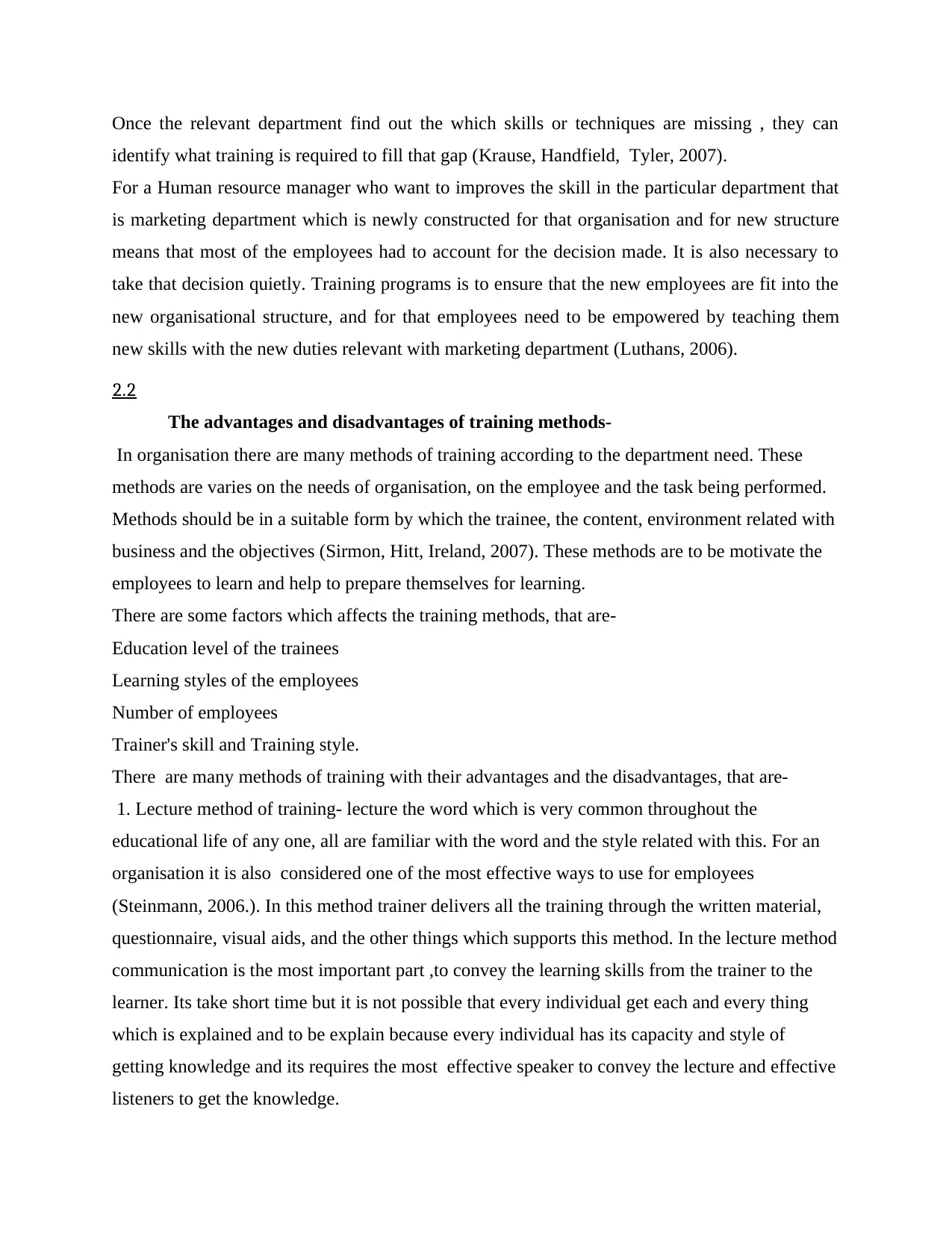
Once the relevant department find out the which skills or techniques are missing , they can
identify what training is required to fill that gap (Krause, Handfield, Tyler, 2007).
For a Human resource manager who want to improves the skill in the particular department that
is marketing department which is newly constructed for that organisation and for new structure
means that most of the employees had to account for the decision made. It is also necessary to
take that decision quietly. Training programs is to ensure that the new employees are fit into the
new organisational structure, and for that employees need to be empowered by teaching them
new skills with the new duties relevant with marketing department (Luthans, 2006).
2.2
The advantages and disadvantages of training methods-
In organisation there are many methods of training according to the department need. These
methods are varies on the needs of organisation, on the employee and the task being performed.
Methods should be in a suitable form by which the trainee, the content, environment related with
business and the objectives (Sirmon, Hitt, Ireland, 2007). These methods are to be motivate the
employees to learn and help to prepare themselves for learning.
There are some factors which affects the training methods, that are-
Education level of the trainees
Learning styles of the employees
Number of employees
Trainer's skill and Training style.
There are many methods of training with their advantages and the disadvantages, that are-
1. Lecture method of training- lecture the word which is very common throughout the
educational life of any one, all are familiar with the word and the style related with this. For an
organisation it is also considered one of the most effective ways to use for employees
(Steinmann, 2006.). In this method trainer delivers all the training through the written material,
questionnaire, visual aids, and the other things which supports this method. In the lecture method
communication is the most important part ,to convey the learning skills from the trainer to the
learner. Its take short time but it is not possible that every individual get each and every thing
which is explained and to be explain because every individual has its capacity and style of
getting knowledge and its requires the most effective speaker to convey the lecture and effective
listeners to get the knowledge.
identify what training is required to fill that gap (Krause, Handfield, Tyler, 2007).
For a Human resource manager who want to improves the skill in the particular department that
is marketing department which is newly constructed for that organisation and for new structure
means that most of the employees had to account for the decision made. It is also necessary to
take that decision quietly. Training programs is to ensure that the new employees are fit into the
new organisational structure, and for that employees need to be empowered by teaching them
new skills with the new duties relevant with marketing department (Luthans, 2006).
2.2
The advantages and disadvantages of training methods-
In organisation there are many methods of training according to the department need. These
methods are varies on the needs of organisation, on the employee and the task being performed.
Methods should be in a suitable form by which the trainee, the content, environment related with
business and the objectives (Sirmon, Hitt, Ireland, 2007). These methods are to be motivate the
employees to learn and help to prepare themselves for learning.
There are some factors which affects the training methods, that are-
Education level of the trainees
Learning styles of the employees
Number of employees
Trainer's skill and Training style.
There are many methods of training with their advantages and the disadvantages, that are-
1. Lecture method of training- lecture the word which is very common throughout the
educational life of any one, all are familiar with the word and the style related with this. For an
organisation it is also considered one of the most effective ways to use for employees
(Steinmann, 2006.). In this method trainer delivers all the training through the written material,
questionnaire, visual aids, and the other things which supports this method. In the lecture method
communication is the most important part ,to convey the learning skills from the trainer to the
learner. Its take short time but it is not possible that every individual get each and every thing
which is explained and to be explain because every individual has its capacity and style of
getting knowledge and its requires the most effective speaker to convey the lecture and effective
listeners to get the knowledge.
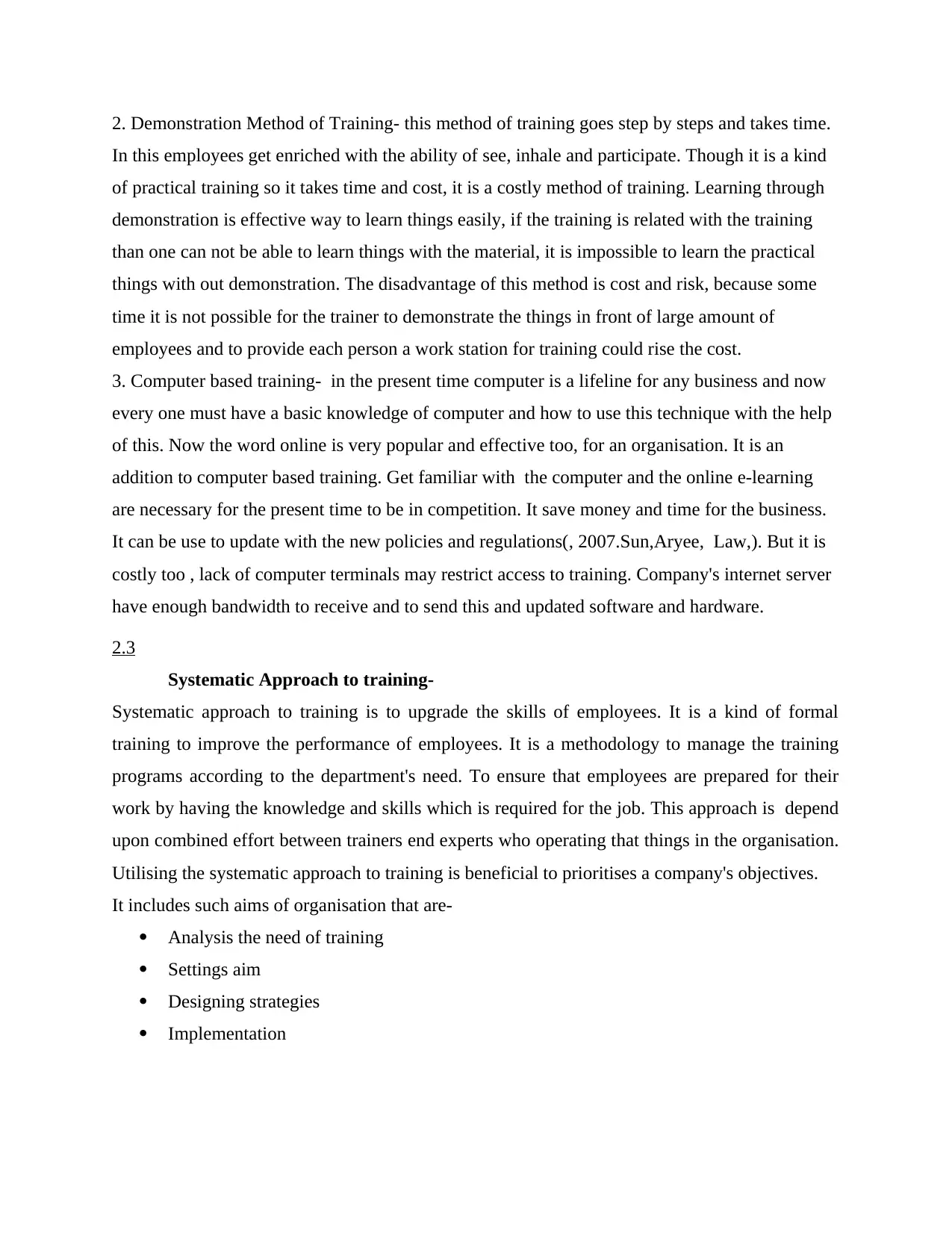
2. Demonstration Method of Training- this method of training goes step by steps and takes time.
In this employees get enriched with the ability of see, inhale and participate. Though it is a kind
of practical training so it takes time and cost, it is a costly method of training. Learning through
demonstration is effective way to learn things easily, if the training is related with the training
than one can not be able to learn things with the material, it is impossible to learn the practical
things with out demonstration. The disadvantage of this method is cost and risk, because some
time it is not possible for the trainer to demonstrate the things in front of large amount of
employees and to provide each person a work station for training could rise the cost.
3. Computer based training- in the present time computer is a lifeline for any business and now
every one must have a basic knowledge of computer and how to use this technique with the help
of this. Now the word online is very popular and effective too, for an organisation. It is an
addition to computer based training. Get familiar with the computer and the online e-learning
are necessary for the present time to be in competition. It save money and time for the business.
It can be use to update with the new policies and regulations(, 2007.Sun,Aryee, Law,). But it is
costly too , lack of computer terminals may restrict access to training. Company's internet server
have enough bandwidth to receive and to send this and updated software and hardware.
2.3
Systematic Approach to training-
Systematic approach to training is to upgrade the skills of employees. It is a kind of formal
training to improve the performance of employees. It is a methodology to manage the training
programs according to the department's need. To ensure that employees are prepared for their
work by having the knowledge and skills which is required for the job. This approach is depend
upon combined effort between trainers end experts who operating that things in the organisation.
Utilising the systematic approach to training is beneficial to prioritises a company's objectives.
It includes such aims of organisation that are-
Analysis the need of training
Settings aim
Designing strategies
Implementation
In this employees get enriched with the ability of see, inhale and participate. Though it is a kind
of practical training so it takes time and cost, it is a costly method of training. Learning through
demonstration is effective way to learn things easily, if the training is related with the training
than one can not be able to learn things with the material, it is impossible to learn the practical
things with out demonstration. The disadvantage of this method is cost and risk, because some
time it is not possible for the trainer to demonstrate the things in front of large amount of
employees and to provide each person a work station for training could rise the cost.
3. Computer based training- in the present time computer is a lifeline for any business and now
every one must have a basic knowledge of computer and how to use this technique with the help
of this. Now the word online is very popular and effective too, for an organisation. It is an
addition to computer based training. Get familiar with the computer and the online e-learning
are necessary for the present time to be in competition. It save money and time for the business.
It can be use to update with the new policies and regulations(, 2007.Sun,Aryee, Law,). But it is
costly too , lack of computer terminals may restrict access to training. Company's internet server
have enough bandwidth to receive and to send this and updated software and hardware.
2.3
Systematic Approach to training-
Systematic approach to training is to upgrade the skills of employees. It is a kind of formal
training to improve the performance of employees. It is a methodology to manage the training
programs according to the department's need. To ensure that employees are prepared for their
work by having the knowledge and skills which is required for the job. This approach is depend
upon combined effort between trainers end experts who operating that things in the organisation.
Utilising the systematic approach to training is beneficial to prioritises a company's objectives.
It includes such aims of organisation that are-
Analysis the need of training
Settings aim
Designing strategies
Implementation
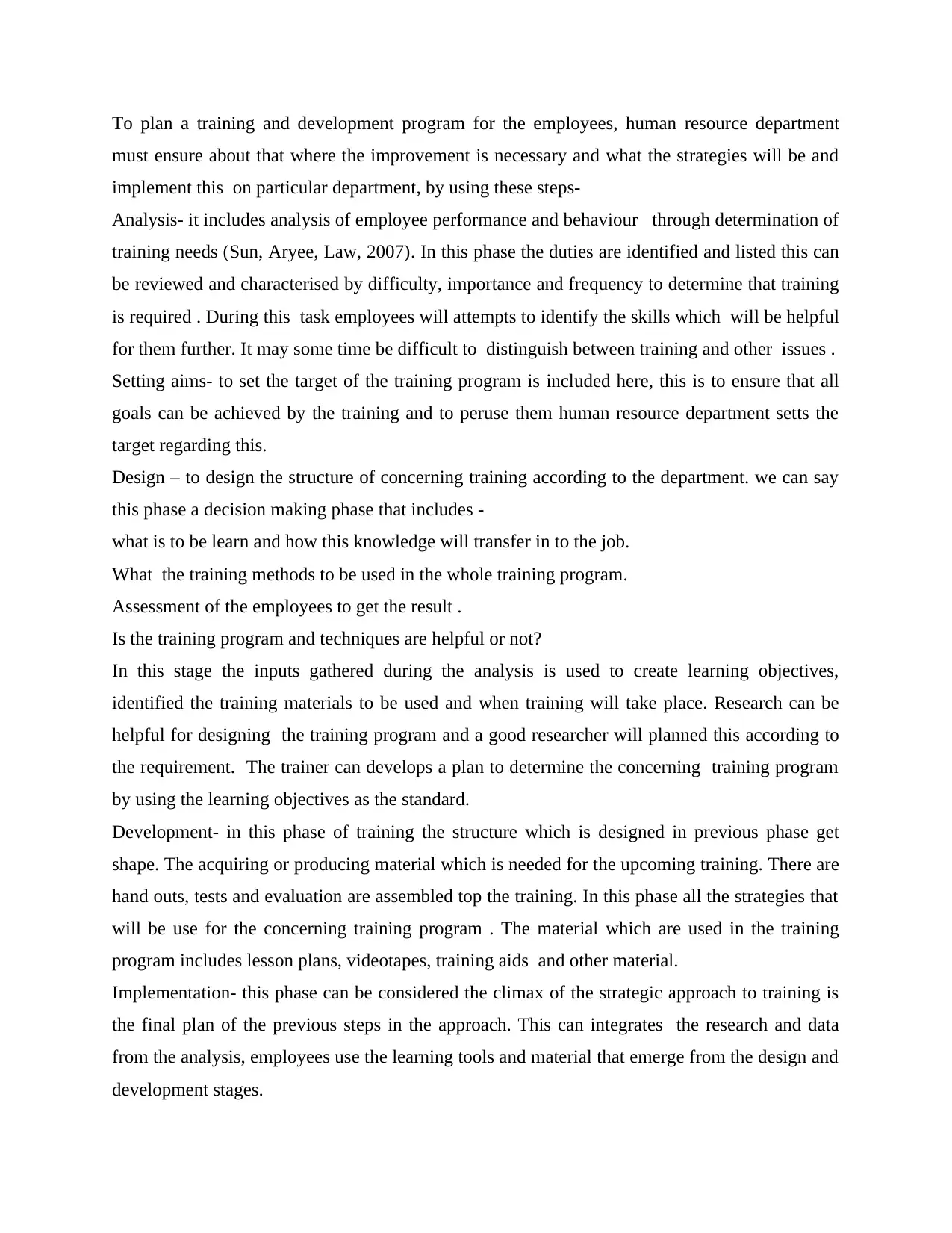
To plan a training and development program for the employees, human resource department
must ensure about that where the improvement is necessary and what the strategies will be and
implement this on particular department, by using these steps-
Analysis- it includes analysis of employee performance and behaviour through determination of
training needs (Sun, Aryee, Law, 2007). In this phase the duties are identified and listed this can
be reviewed and characterised by difficulty, importance and frequency to determine that training
is required . During this task employees will attempts to identify the skills which will be helpful
for them further. It may some time be difficult to distinguish between training and other issues .
Setting aims- to set the target of the training program is included here, this is to ensure that all
goals can be achieved by the training and to peruse them human resource department setts the
target regarding this.
Design – to design the structure of concerning training according to the department. we can say
this phase a decision making phase that includes -
what is to be learn and how this knowledge will transfer in to the job.
What the training methods to be used in the whole training program.
Assessment of the employees to get the result .
Is the training program and techniques are helpful or not?
In this stage the inputs gathered during the analysis is used to create learning objectives,
identified the training materials to be used and when training will take place. Research can be
helpful for designing the training program and a good researcher will planned this according to
the requirement. The trainer can develops a plan to determine the concerning training program
by using the learning objectives as the standard.
Development- in this phase of training the structure which is designed in previous phase get
shape. The acquiring or producing material which is needed for the upcoming training. There are
hand outs, tests and evaluation are assembled top the training. In this phase all the strategies that
will be use for the concerning training program . The material which are used in the training
program includes lesson plans, videotapes, training aids and other material.
Implementation- this phase can be considered the climax of the strategic approach to training is
the final plan of the previous steps in the approach. This can integrates the research and data
from the analysis, employees use the learning tools and material that emerge from the design and
development stages.
must ensure about that where the improvement is necessary and what the strategies will be and
implement this on particular department, by using these steps-
Analysis- it includes analysis of employee performance and behaviour through determination of
training needs (Sun, Aryee, Law, 2007). In this phase the duties are identified and listed this can
be reviewed and characterised by difficulty, importance and frequency to determine that training
is required . During this task employees will attempts to identify the skills which will be helpful
for them further. It may some time be difficult to distinguish between training and other issues .
Setting aims- to set the target of the training program is included here, this is to ensure that all
goals can be achieved by the training and to peruse them human resource department setts the
target regarding this.
Design – to design the structure of concerning training according to the department. we can say
this phase a decision making phase that includes -
what is to be learn and how this knowledge will transfer in to the job.
What the training methods to be used in the whole training program.
Assessment of the employees to get the result .
Is the training program and techniques are helpful or not?
In this stage the inputs gathered during the analysis is used to create learning objectives,
identified the training materials to be used and when training will take place. Research can be
helpful for designing the training program and a good researcher will planned this according to
the requirement. The trainer can develops a plan to determine the concerning training program
by using the learning objectives as the standard.
Development- in this phase of training the structure which is designed in previous phase get
shape. The acquiring or producing material which is needed for the upcoming training. There are
hand outs, tests and evaluation are assembled top the training. In this phase all the strategies that
will be use for the concerning training program . The material which are used in the training
program includes lesson plans, videotapes, training aids and other material.
Implementation- this phase can be considered the climax of the strategic approach to training is
the final plan of the previous steps in the approach. This can integrates the research and data
from the analysis, employees use the learning tools and material that emerge from the design and
development stages.
Secure Best Marks with AI Grader
Need help grading? Try our AI Grader for instant feedback on your assignments.
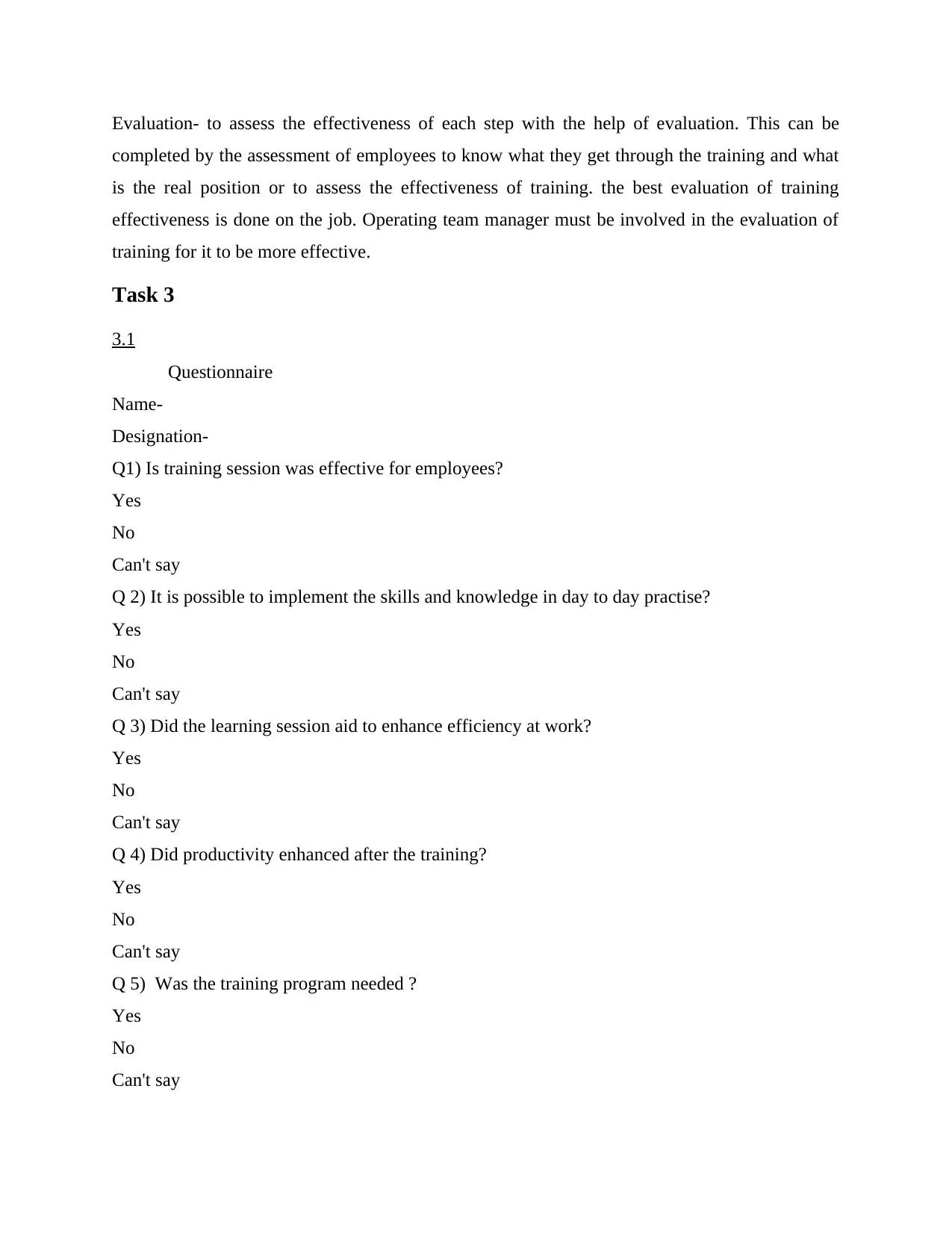
Evaluation- to assess the effectiveness of each step with the help of evaluation. This can be
completed by the assessment of employees to know what they get through the training and what
is the real position or to assess the effectiveness of training. the best evaluation of training
effectiveness is done on the job. Operating team manager must be involved in the evaluation of
training for it to be more effective.
Task 3
3.1
Questionnaire
Name-
Designation-
Q1) Is training session was effective for employees?
Yes
No
Can't say
Q 2) It is possible to implement the skills and knowledge in day to day practise?
Yes
No
Can't say
Q 3) Did the learning session aid to enhance efficiency at work?
Yes
No
Can't say
Q 4) Did productivity enhanced after the training?
Yes
No
Can't say
Q 5) Was the training program needed ?
Yes
No
Can't say
completed by the assessment of employees to know what they get through the training and what
is the real position or to assess the effectiveness of training. the best evaluation of training
effectiveness is done on the job. Operating team manager must be involved in the evaluation of
training for it to be more effective.
Task 3
3.1
Questionnaire
Name-
Designation-
Q1) Is training session was effective for employees?
Yes
No
Can't say
Q 2) It is possible to implement the skills and knowledge in day to day practise?
Yes
No
Can't say
Q 3) Did the learning session aid to enhance efficiency at work?
Yes
No
Can't say
Q 4) Did productivity enhanced after the training?
Yes
No
Can't say
Q 5) Was the training program needed ?
Yes
No
Can't say
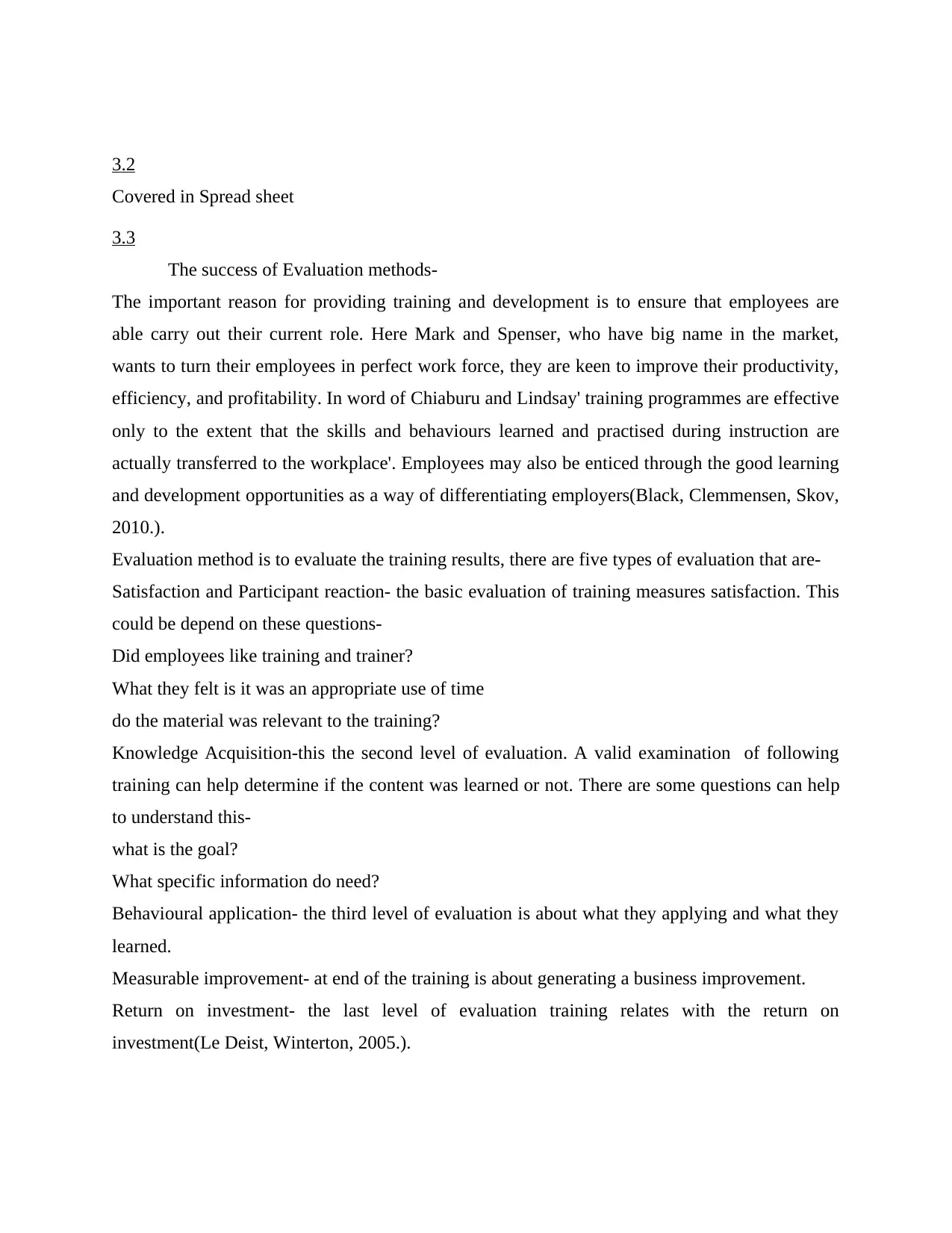
3.2
Covered in Spread sheet
3.3
The success of Evaluation methods-
The important reason for providing training and development is to ensure that employees are
able carry out their current role. Here Mark and Spenser, who have big name in the market,
wants to turn their employees in perfect work force, they are keen to improve their productivity,
efficiency, and profitability. In word of Chiaburu and Lindsay' training programmes are effective
only to the extent that the skills and behaviours learned and practised during instruction are
actually transferred to the workplace'. Employees may also be enticed through the good learning
and development opportunities as a way of differentiating employers(Black, Clemmensen, Skov,
2010.).
Evaluation method is to evaluate the training results, there are five types of evaluation that are-
Satisfaction and Participant reaction- the basic evaluation of training measures satisfaction. This
could be depend on these questions-
Did employees like training and trainer?
What they felt is it was an appropriate use of time
do the material was relevant to the training?
Knowledge Acquisition-this the second level of evaluation. A valid examination of following
training can help determine if the content was learned or not. There are some questions can help
to understand this-
what is the goal?
What specific information do need?
Behavioural application- the third level of evaluation is about what they applying and what they
learned.
Measurable improvement- at end of the training is about generating a business improvement.
Return on investment- the last level of evaluation training relates with the return on
investment(Le Deist, Winterton, 2005.).
Covered in Spread sheet
3.3
The success of Evaluation methods-
The important reason for providing training and development is to ensure that employees are
able carry out their current role. Here Mark and Spenser, who have big name in the market,
wants to turn their employees in perfect work force, they are keen to improve their productivity,
efficiency, and profitability. In word of Chiaburu and Lindsay' training programmes are effective
only to the extent that the skills and behaviours learned and practised during instruction are
actually transferred to the workplace'. Employees may also be enticed through the good learning
and development opportunities as a way of differentiating employers(Black, Clemmensen, Skov,
2010.).
Evaluation method is to evaluate the training results, there are five types of evaluation that are-
Satisfaction and Participant reaction- the basic evaluation of training measures satisfaction. This
could be depend on these questions-
Did employees like training and trainer?
What they felt is it was an appropriate use of time
do the material was relevant to the training?
Knowledge Acquisition-this the second level of evaluation. A valid examination of following
training can help determine if the content was learned or not. There are some questions can help
to understand this-
what is the goal?
What specific information do need?
Behavioural application- the third level of evaluation is about what they applying and what they
learned.
Measurable improvement- at end of the training is about generating a business improvement.
Return on investment- the last level of evaluation training relates with the return on
investment(Le Deist, Winterton, 2005.).

Task 4
4.1
Government is highlight the very important of training and development as they aim to reduce
the barriers of employability of those that have fewer opportunities to do so. The idea of ‘life-
long learning’ is becoming the important initiative of the government to create such
opportunities to a wide-range of communities and background(Kang, Morris, Snell, 2007.).
Training is a vital part of every employee and employer. Training refers as the process of
learning and being conditioned. Training is very important for the individual development and
progress of the worker. Training and development are also require for update employees of the
market trends and the change in the employment policies. The main objective of training and
development is to help employees in gaining their personal goals. Both training and development
are continuous process of organization.
The role of government in training, development and lifelong learning are:
The life-long learning aim is remove social exclusions which will help to increase employability
and active citizenship among communities. Lifelong learning has been attached to a various of
benefits, for the people, the economy and society. Lifelong learning has a positive impact on life
satisfaction and well-being(Krause, Handfield, Tyler, 2007.).
Government control a consequential role in the training and development of the employees of
private organization. Government arrange training programs through expert trainer to make sure
the individual can develop and reach at least a minimum standard of performance. Government
is responsible about the internal development of the organization’s performance and also
responsible to take the performance to a standard level. Lifelong learning is the self-motivated
learning by employees. Government conduct a training and development programmes for the
employees to pursuit knowledge from the working environment. Many organizations might not
be able to arrange in high amount and design the needed training facilities. In this case the
organizations are benefitted through the national government. In competitive market, it is helps
to create an advantage situation for the organization(Sirmon, Hitt, Ireland, 2007.).
4.1
Government is highlight the very important of training and development as they aim to reduce
the barriers of employability of those that have fewer opportunities to do so. The idea of ‘life-
long learning’ is becoming the important initiative of the government to create such
opportunities to a wide-range of communities and background(Kang, Morris, Snell, 2007.).
Training is a vital part of every employee and employer. Training refers as the process of
learning and being conditioned. Training is very important for the individual development and
progress of the worker. Training and development are also require for update employees of the
market trends and the change in the employment policies. The main objective of training and
development is to help employees in gaining their personal goals. Both training and development
are continuous process of organization.
The role of government in training, development and lifelong learning are:
The life-long learning aim is remove social exclusions which will help to increase employability
and active citizenship among communities. Lifelong learning has been attached to a various of
benefits, for the people, the economy and society. Lifelong learning has a positive impact on life
satisfaction and well-being(Krause, Handfield, Tyler, 2007.).
Government control a consequential role in the training and development of the employees of
private organization. Government arrange training programs through expert trainer to make sure
the individual can develop and reach at least a minimum standard of performance. Government
is responsible about the internal development of the organization’s performance and also
responsible to take the performance to a standard level. Lifelong learning is the self-motivated
learning by employees. Government conduct a training and development programmes for the
employees to pursuit knowledge from the working environment. Many organizations might not
be able to arrange in high amount and design the needed training facilities. In this case the
organizations are benefitted through the national government. In competitive market, it is helps
to create an advantage situation for the organization(Sirmon, Hitt, Ireland, 2007.).
Paraphrase This Document
Need a fresh take? Get an instant paraphrase of this document with our AI Paraphraser
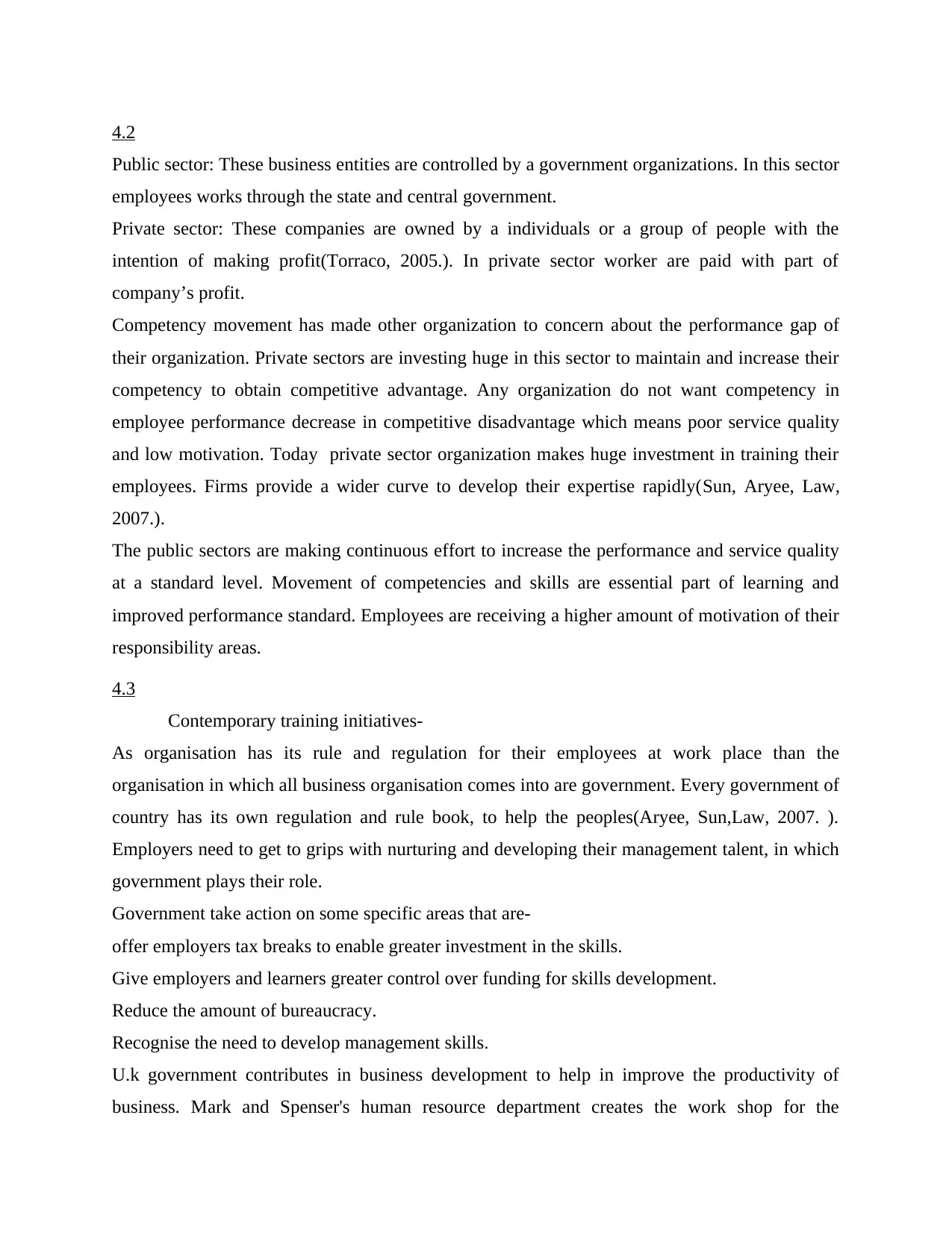
4.2
Public sector: These business entities are controlled by a government organizations. In this sector
employees works through the state and central government.
Private sector: These companies are owned by a individuals or a group of people with the
intention of making profit(Torraco, 2005.). In private sector worker are paid with part of
company’s profit.
Competency movement has made other organization to concern about the performance gap of
their organization. Private sectors are investing huge in this sector to maintain and increase their
competency to obtain competitive advantage. Any organization do not want competency in
employee performance decrease in competitive disadvantage which means poor service quality
and low motivation. Today private sector organization makes huge investment in training their
employees. Firms provide a wider curve to develop their expertise rapidly(Sun, Aryee, Law,
2007.).
The public sectors are making continuous effort to increase the performance and service quality
at a standard level. Movement of competencies and skills are essential part of learning and
improved performance standard. Employees are receiving a higher amount of motivation of their
responsibility areas.
4.3
Contemporary training initiatives-
As organisation has its rule and regulation for their employees at work place than the
organisation in which all business organisation comes into are government. Every government of
country has its own regulation and rule book, to help the peoples(Aryee, Sun,Law, 2007. ).
Employers need to get to grips with nurturing and developing their management talent, in which
government plays their role.
Government take action on some specific areas that are-
offer employers tax breaks to enable greater investment in the skills.
Give employers and learners greater control over funding for skills development.
Reduce the amount of bureaucracy.
Recognise the need to develop management skills.
U.k government contributes in business development to help in improve the productivity of
business. Mark and Spenser's human resource department creates the work shop for the
Public sector: These business entities are controlled by a government organizations. In this sector
employees works through the state and central government.
Private sector: These companies are owned by a individuals or a group of people with the
intention of making profit(Torraco, 2005.). In private sector worker are paid with part of
company’s profit.
Competency movement has made other organization to concern about the performance gap of
their organization. Private sectors are investing huge in this sector to maintain and increase their
competency to obtain competitive advantage. Any organization do not want competency in
employee performance decrease in competitive disadvantage which means poor service quality
and low motivation. Today private sector organization makes huge investment in training their
employees. Firms provide a wider curve to develop their expertise rapidly(Sun, Aryee, Law,
2007.).
The public sectors are making continuous effort to increase the performance and service quality
at a standard level. Movement of competencies and skills are essential part of learning and
improved performance standard. Employees are receiving a higher amount of motivation of their
responsibility areas.
4.3
Contemporary training initiatives-
As organisation has its rule and regulation for their employees at work place than the
organisation in which all business organisation comes into are government. Every government of
country has its own regulation and rule book, to help the peoples(Aryee, Sun,Law, 2007. ).
Employers need to get to grips with nurturing and developing their management talent, in which
government plays their role.
Government take action on some specific areas that are-
offer employers tax breaks to enable greater investment in the skills.
Give employers and learners greater control over funding for skills development.
Reduce the amount of bureaucracy.
Recognise the need to develop management skills.
U.k government contributes in business development to help in improve the productivity of
business. Mark and Spenser's human resource department creates the work shop for the
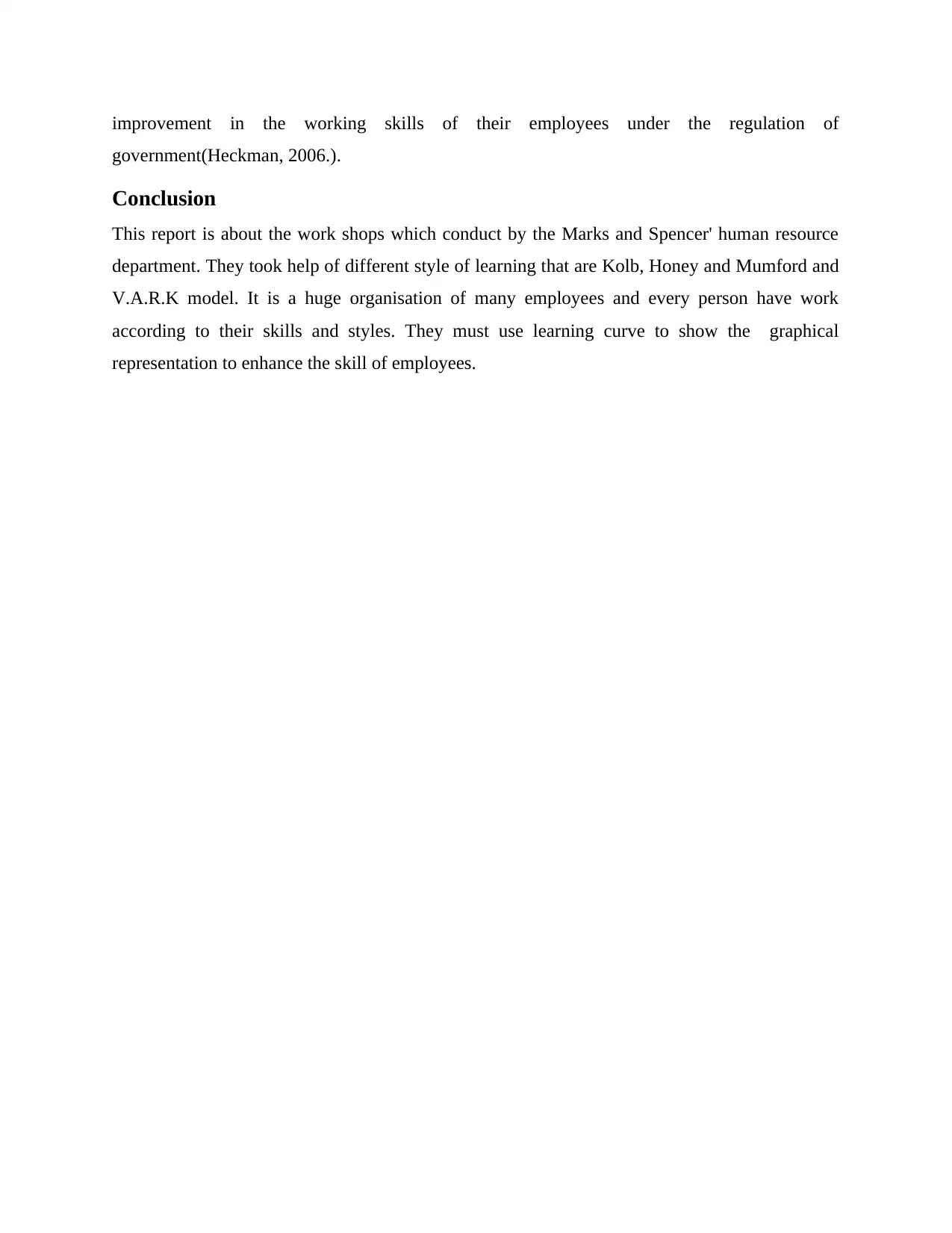
improvement in the working skills of their employees under the regulation of
government(Heckman, 2006.).
Conclusion
This report is about the work shops which conduct by the Marks and Spencer' human resource
department. They took help of different style of learning that are Kolb, Honey and Mumford and
V.A.R.K model. It is a huge organisation of many employees and every person have work
according to their skills and styles. They must use learning curve to show the graphical
representation to enhance the skill of employees.
government(Heckman, 2006.).
Conclusion
This report is about the work shops which conduct by the Marks and Spencer' human resource
department. They took help of different style of learning that are Kolb, Honey and Mumford and
V.A.R.K model. It is a huge organisation of many employees and every person have work
according to their skills and styles. They must use learning curve to show the graphical
representation to enhance the skill of employees.
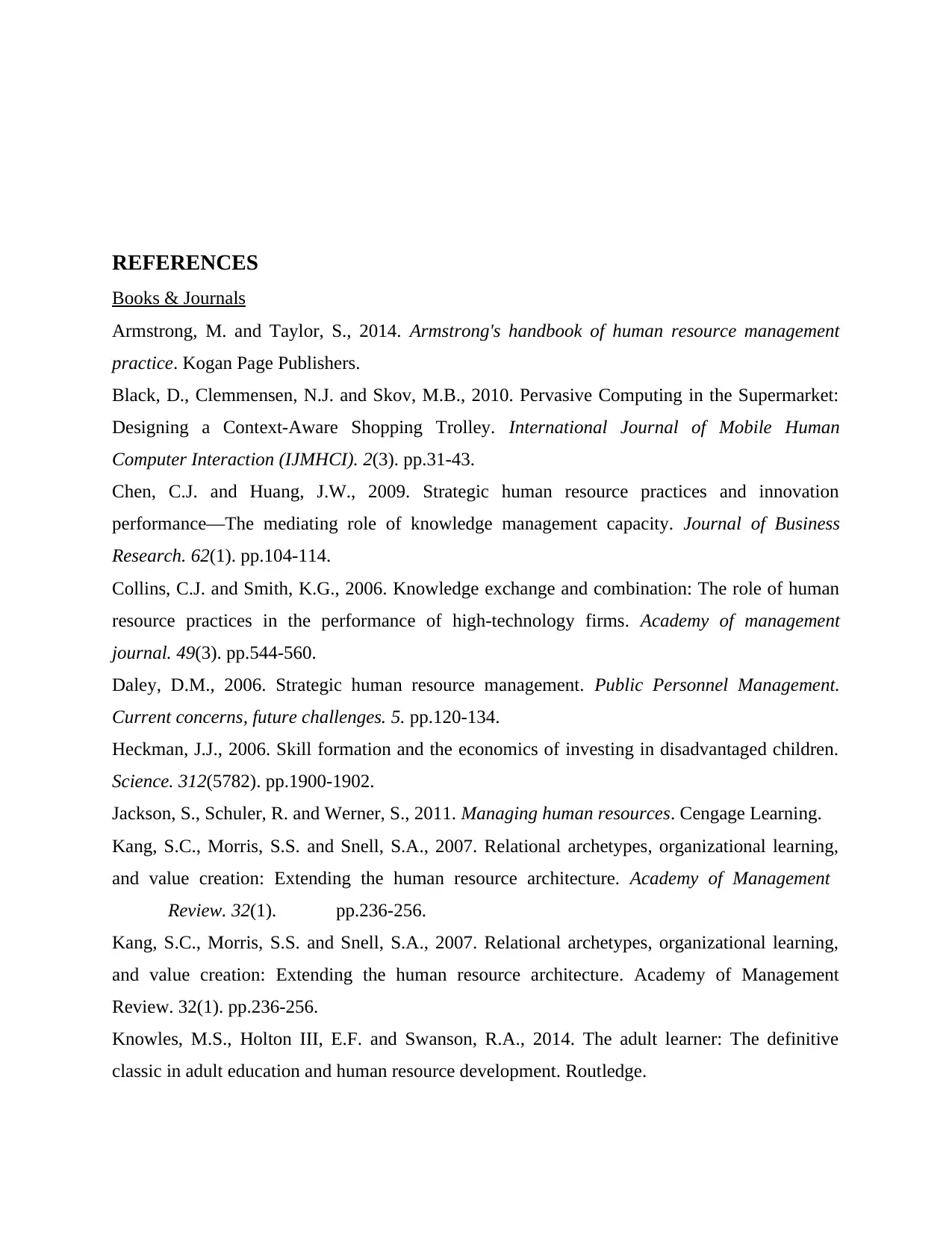
REFERENCES
Books & Journals
Armstrong, M. and Taylor, S., 2014. Armstrong's handbook of human resource management
practice. Kogan Page Publishers.
Black, D., Clemmensen, N.J. and Skov, M.B., 2010. Pervasive Computing in the Supermarket:
Designing a Context-Aware Shopping Trolley. International Journal of Mobile Human
Computer Interaction (IJMHCI). 2(3). pp.31-43.
Chen, C.J. and Huang, J.W., 2009. Strategic human resource practices and innovation
performance—The mediating role of knowledge management capacity. Journal of Business
Research. 62(1). pp.104-114.
Collins, C.J. and Smith, K.G., 2006. Knowledge exchange and combination: The role of human
resource practices in the performance of high-technology firms. Academy of management
journal. 49(3). pp.544-560.
Daley, D.M., 2006. Strategic human resource management. Public Personnel Management.
Current concerns, future challenges. 5. pp.120-134.
Heckman, J.J., 2006. Skill formation and the economics of investing in disadvantaged children.
Science. 312(5782). pp.1900-1902.
Jackson, S., Schuler, R. and Werner, S., 2011. Managing human resources. Cengage Learning.
Kang, S.C., Morris, S.S. and Snell, S.A., 2007. Relational archetypes, organizational learning,
and value creation: Extending the human resource architecture. Academy of Management
Review. 32(1). pp.236-256.
Kang, S.C., Morris, S.S. and Snell, S.A., 2007. Relational archetypes, organizational learning,
and value creation: Extending the human resource architecture. Academy of Management
Review. 32(1). pp.236-256.
Knowles, M.S., Holton III, E.F. and Swanson, R.A., 2014. The adult learner: The definitive
classic in adult education and human resource development. Routledge.
Books & Journals
Armstrong, M. and Taylor, S., 2014. Armstrong's handbook of human resource management
practice. Kogan Page Publishers.
Black, D., Clemmensen, N.J. and Skov, M.B., 2010. Pervasive Computing in the Supermarket:
Designing a Context-Aware Shopping Trolley. International Journal of Mobile Human
Computer Interaction (IJMHCI). 2(3). pp.31-43.
Chen, C.J. and Huang, J.W., 2009. Strategic human resource practices and innovation
performance—The mediating role of knowledge management capacity. Journal of Business
Research. 62(1). pp.104-114.
Collins, C.J. and Smith, K.G., 2006. Knowledge exchange and combination: The role of human
resource practices in the performance of high-technology firms. Academy of management
journal. 49(3). pp.544-560.
Daley, D.M., 2006. Strategic human resource management. Public Personnel Management.
Current concerns, future challenges. 5. pp.120-134.
Heckman, J.J., 2006. Skill formation and the economics of investing in disadvantaged children.
Science. 312(5782). pp.1900-1902.
Jackson, S., Schuler, R. and Werner, S., 2011. Managing human resources. Cengage Learning.
Kang, S.C., Morris, S.S. and Snell, S.A., 2007. Relational archetypes, organizational learning,
and value creation: Extending the human resource architecture. Academy of Management
Review. 32(1). pp.236-256.
Kang, S.C., Morris, S.S. and Snell, S.A., 2007. Relational archetypes, organizational learning,
and value creation: Extending the human resource architecture. Academy of Management
Review. 32(1). pp.236-256.
Knowles, M.S., Holton III, E.F. and Swanson, R.A., 2014. The adult learner: The definitive
classic in adult education and human resource development. Routledge.
Secure Best Marks with AI Grader
Need help grading? Try our AI Grader for instant feedback on your assignments.
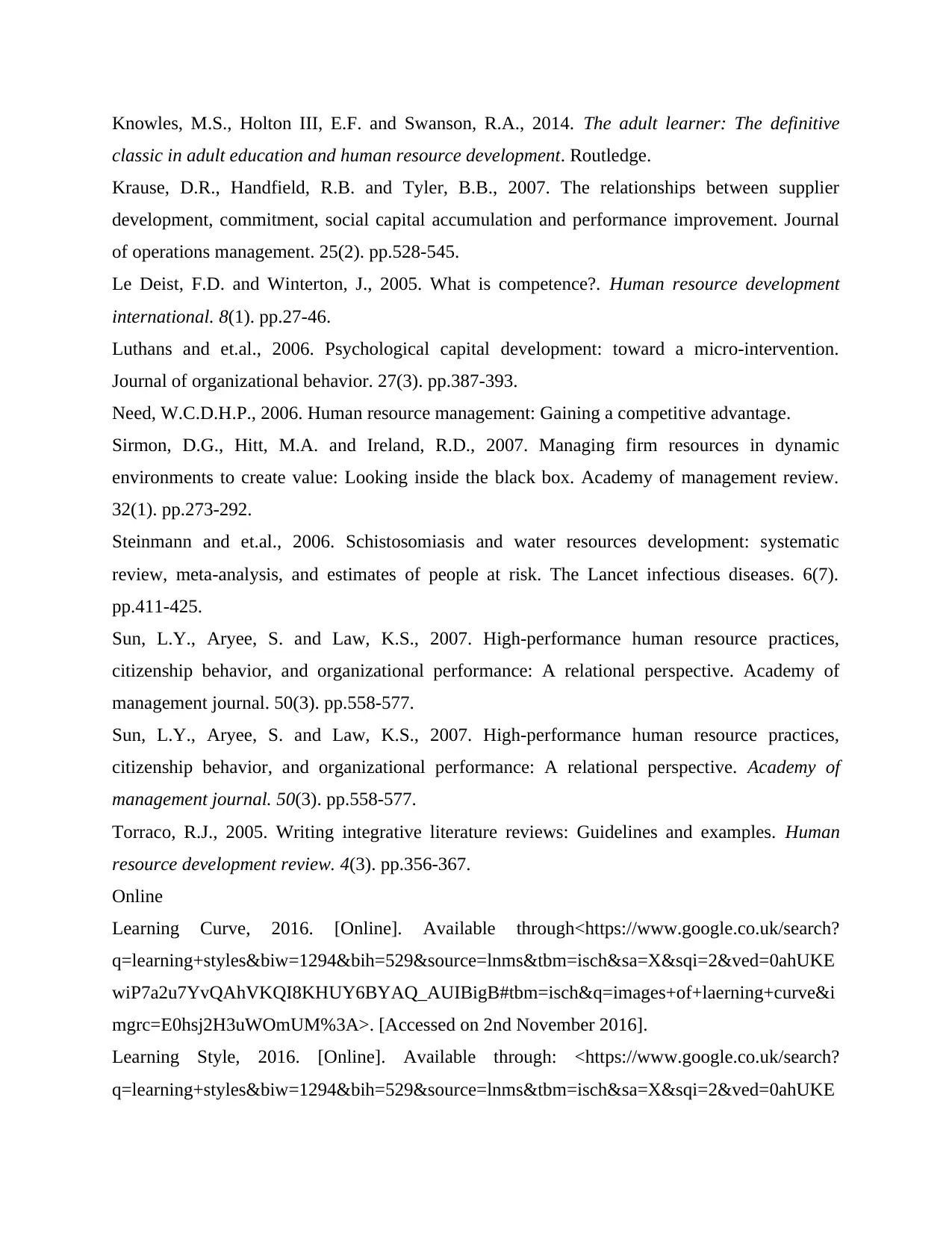
Knowles, M.S., Holton III, E.F. and Swanson, R.A., 2014. The adult learner: The definitive
classic in adult education and human resource development. Routledge.
Krause, D.R., Handfield, R.B. and Tyler, B.B., 2007. The relationships between supplier
development, commitment, social capital accumulation and performance improvement. Journal
of operations management. 25(2). pp.528-545.
Le Deist, F.D. and Winterton, J., 2005. What is competence?. Human resource development
international. 8(1). pp.27-46.
Luthans and et.al., 2006. Psychological capital development: toward a micro‐intervention.
Journal of organizational behavior. 27(3). pp.387-393.
Need, W.C.D.H.P., 2006. Human resource management: Gaining a competitive advantage.
Sirmon, D.G., Hitt, M.A. and Ireland, R.D., 2007. Managing firm resources in dynamic
environments to create value: Looking inside the black box. Academy of management review.
32(1). pp.273-292.
Steinmann and et.al., 2006. Schistosomiasis and water resources development: systematic
review, meta-analysis, and estimates of people at risk. The Lancet infectious diseases. 6(7).
pp.411-425.
Sun, L.Y., Aryee, S. and Law, K.S., 2007. High-performance human resource practices,
citizenship behavior, and organizational performance: A relational perspective. Academy of
management journal. 50(3). pp.558-577.
Sun, L.Y., Aryee, S. and Law, K.S., 2007. High-performance human resource practices,
citizenship behavior, and organizational performance: A relational perspective. Academy of
management journal. 50(3). pp.558-577.
Torraco, R.J., 2005. Writing integrative literature reviews: Guidelines and examples. Human
resource development review. 4(3). pp.356-367.
Online
Learning Curve, 2016. [Online]. Available through<https://www.google.co.uk/search?
q=learning+styles&biw=1294&bih=529&source=lnms&tbm=isch&sa=X&sqi=2&ved=0ahUKE
wiP7a2u7YvQAhVKQI8KHUY6BYAQ_AUIBigB#tbm=isch&q=images+of+laerning+curve&i
mgrc=E0hsj2H3uWOmUM%3A>. [Accessed on 2nd November 2016].
Learning Style, 2016. [Online]. Available through: <https://www.google.co.uk/search?
q=learning+styles&biw=1294&bih=529&source=lnms&tbm=isch&sa=X&sqi=2&ved=0ahUKE
classic in adult education and human resource development. Routledge.
Krause, D.R., Handfield, R.B. and Tyler, B.B., 2007. The relationships between supplier
development, commitment, social capital accumulation and performance improvement. Journal
of operations management. 25(2). pp.528-545.
Le Deist, F.D. and Winterton, J., 2005. What is competence?. Human resource development
international. 8(1). pp.27-46.
Luthans and et.al., 2006. Psychological capital development: toward a micro‐intervention.
Journal of organizational behavior. 27(3). pp.387-393.
Need, W.C.D.H.P., 2006. Human resource management: Gaining a competitive advantage.
Sirmon, D.G., Hitt, M.A. and Ireland, R.D., 2007. Managing firm resources in dynamic
environments to create value: Looking inside the black box. Academy of management review.
32(1). pp.273-292.
Steinmann and et.al., 2006. Schistosomiasis and water resources development: systematic
review, meta-analysis, and estimates of people at risk. The Lancet infectious diseases. 6(7).
pp.411-425.
Sun, L.Y., Aryee, S. and Law, K.S., 2007. High-performance human resource practices,
citizenship behavior, and organizational performance: A relational perspective. Academy of
management journal. 50(3). pp.558-577.
Sun, L.Y., Aryee, S. and Law, K.S., 2007. High-performance human resource practices,
citizenship behavior, and organizational performance: A relational perspective. Academy of
management journal. 50(3). pp.558-577.
Torraco, R.J., 2005. Writing integrative literature reviews: Guidelines and examples. Human
resource development review. 4(3). pp.356-367.
Online
Learning Curve, 2016. [Online]. Available through<https://www.google.co.uk/search?
q=learning+styles&biw=1294&bih=529&source=lnms&tbm=isch&sa=X&sqi=2&ved=0ahUKE
wiP7a2u7YvQAhVKQI8KHUY6BYAQ_AUIBigB#tbm=isch&q=images+of+laerning+curve&i
mgrc=E0hsj2H3uWOmUM%3A>. [Accessed on 2nd November 2016].
Learning Style, 2016. [Online]. Available through: <https://www.google.co.uk/search?
q=learning+styles&biw=1294&bih=529&source=lnms&tbm=isch&sa=X&sqi=2&ved=0ahUKE

wiP7a2u7YvQAhVKQI8KHUY6BYAQ_AUIBigB#tbm=isch&q=learning+styles+visual+audito
ry+kinesthetic&imgrc=udzhKPWnQSLtcM%3A>. [Accessed on 2nd November 2016].
ry+kinesthetic&imgrc=udzhKPWnQSLtcM%3A>. [Accessed on 2nd November 2016].
1 out of 18
Related Documents
Your All-in-One AI-Powered Toolkit for Academic Success.
+13062052269
info@desklib.com
Available 24*7 on WhatsApp / Email
![[object Object]](/_next/static/media/star-bottom.7253800d.svg)
Unlock your academic potential
© 2024 | Zucol Services PVT LTD | All rights reserved.





